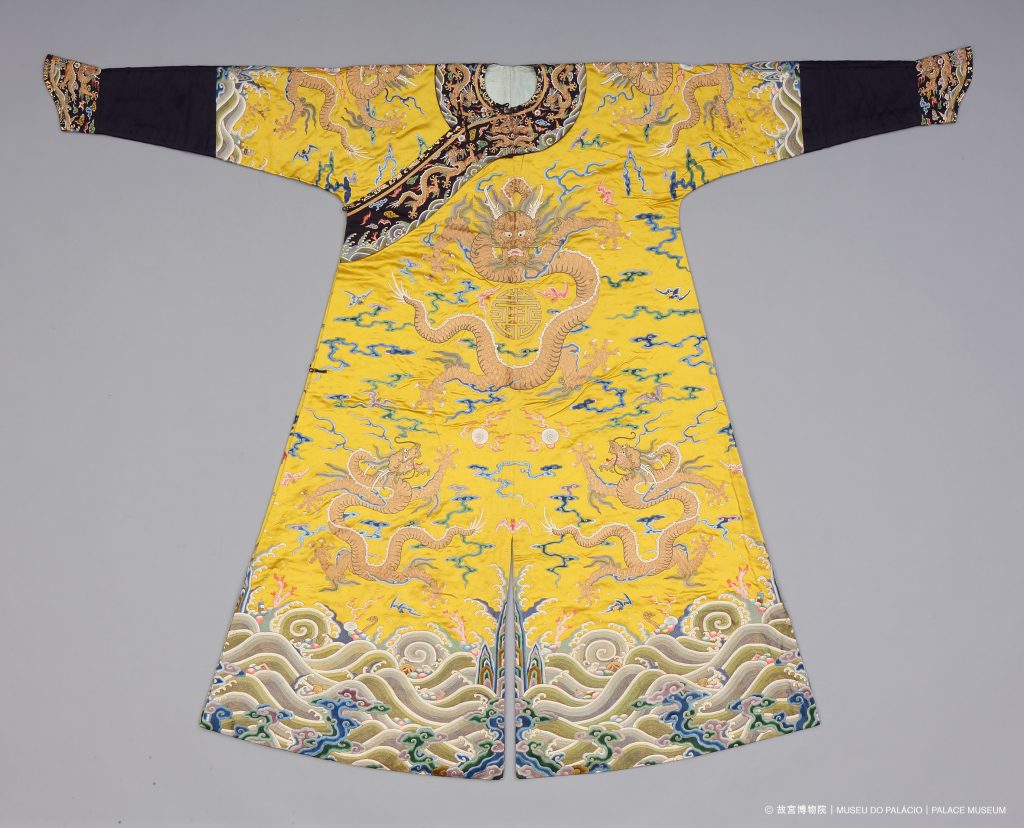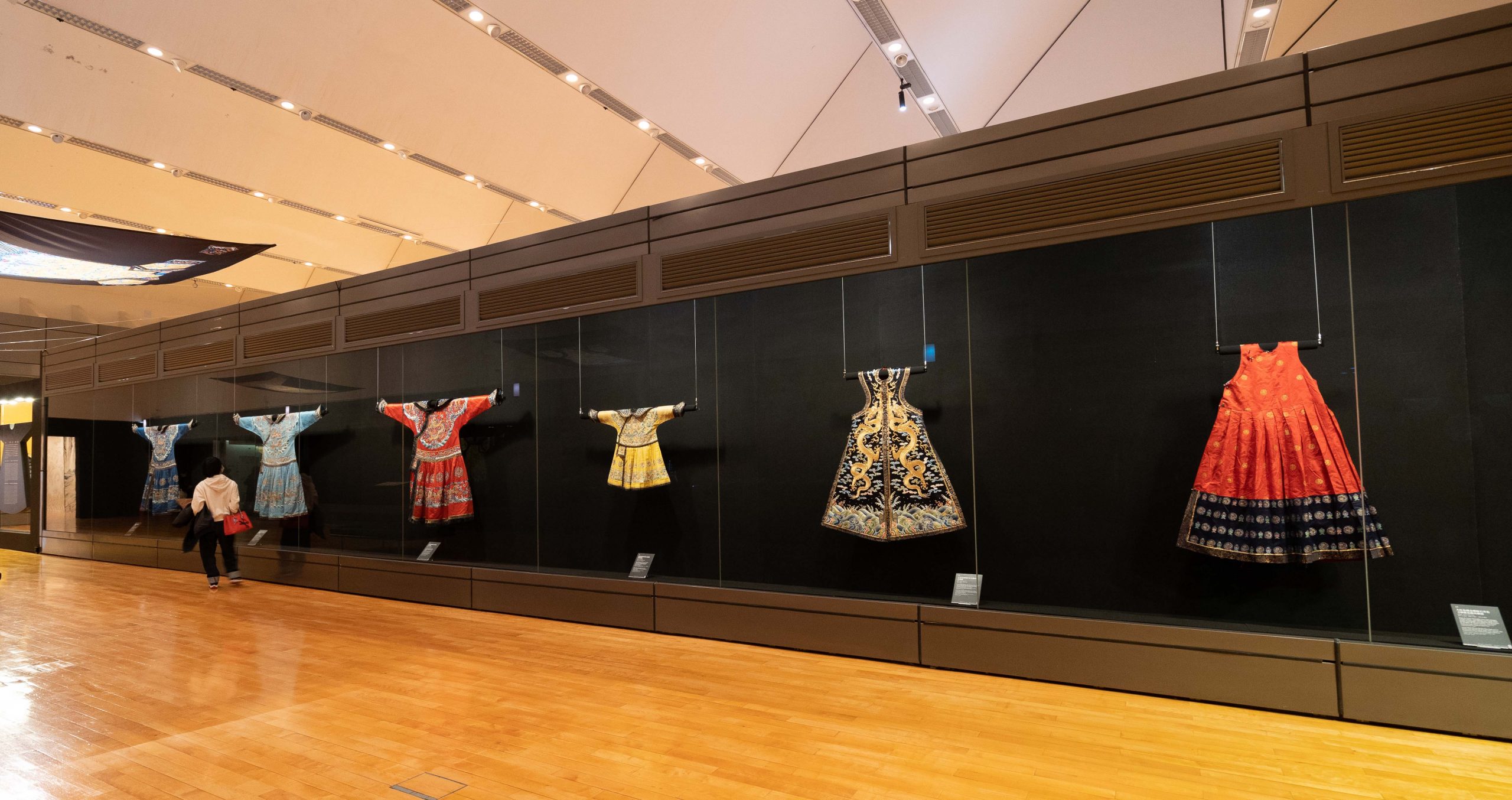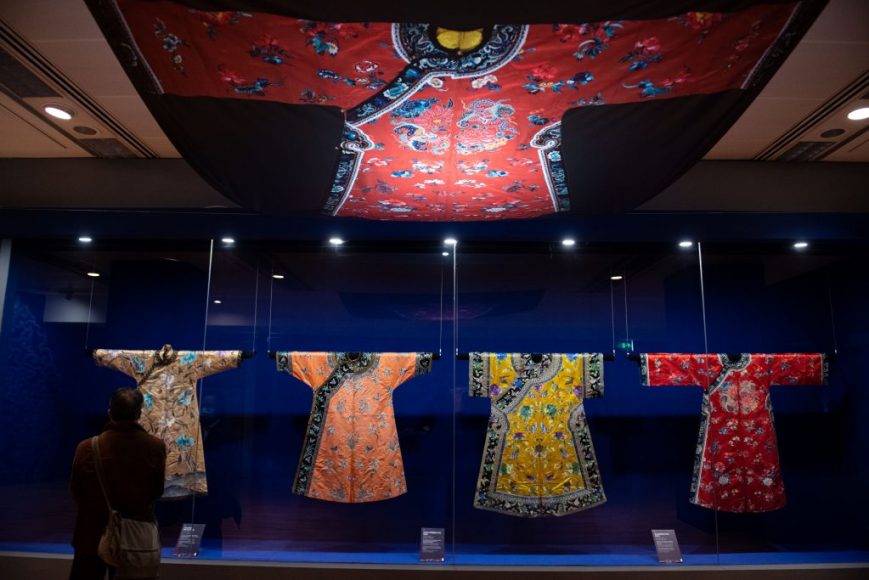The Macao Museum of Art showcases some of the most beautiful costumes and accessories that were once worn by China’s emperors and empresses.
Few cultures and countries around the world can match China when it comes to ancient regal costumes. The Egyptians and the Japanese certainly have a special place, as do countries across Europe, such as England, France, Spain and Portugal.
These nations all have old paintings that line the walls of galleries and museums showing historical kings and queens adorned in beautiful clothes, with precious stones sewn into them or on crowns that glimmer in the light. However, there’s something really quite special about the costumes once worn by China’s emperors and empresses.
These old items of regal clothing hold a special place in Macao over the next couple of months as they are being showcased at the Macao Museum of Art (MAM) in a vast exhibition called ‘Stately Demeanour: Costumes of Qing Emperors and Empresses from the Collection of the Palace Museum’. The display, which opened on 17 December and is running until 14 March, saw more than 10,000 locals visit it during its first three weeks alone.
The exhibition is co-organised by the MAM and the Palace Museum, which sits within the Forbidden City in Beijing. The display, which showcases about 90 sets of costumes and accessories that were worn by Qing dynasty emperors and empresses, also marks the 21st year of collaboration between the museum and the MAM. Exhibition co-ordinator Irene Hoi Ian Chio says: “We started thinking about the exhibition’s theme around three years ago after the success of the ‘Qing palace TV’ dramas, which were Chinese TV shows based in the Qing dynasty that had so many viewers hooked. In the past, we have exhibited calligraphy works and paintings from the Ming and Qing dynasties. This time, we wanted to bring some exhibits of daily life to our audience.” Chio adds that the exhibits are unique: “Among the exhibits, there are 12 pieces that have never left the Palace Museum before. Plus, this is the MAM’s first exhibition that showcases the costumes of emperors and empresses.”
Plenty of drama
The Qing dynasty ruled China from 1644 to 1911 and, ever since, it’s been a dynasty that’s stayed in the hearts and minds of people across the globe. Over the past few years, TV has done its part to keep it alive on the small screen. For instance, in 2018 two Chinese period dramas drew critical acclaim. The ‘Story of Yanxi Palace’ was set during the sixth year of the Qianlong Emperor’s reign – he was the sixth emperor of the Qing dynasty. And ‘Ruyi’s Royal Love in the Palace’ chronicled the marriage of the Qianlong Emperor and Hoifa-Nara, the Step-Empress. Often, these shows ran fictitious tales about power battles among the Qianlong Emperor’s concubines in the 18th century. Both series offered different interpretations of the characters at court with remarkable catfight plotting and fine performances – but what frequently fascinated audiences most was the sumptuously detailed costumes on-screen. Chio says: “Visitors [to the Macao exhibition] are interested because they’ve seen the beautiful details on the TV shows. Among the exhibits are costumes that were actually worn by the real Qianlong Emperor, as well as the Kangxi and Jiaqing emperors too.”

robe with satin embroidery of polychrome clouds and golden dragons worn by the Yongzheng Emperor between 1723 and 1735丨Photo courtesy of the Palace Museum
The devil really is in the detail for Chio. She says that the fine details within each costume and accessory have attracted many visitors to the exhibition. And she adds that this influx of interest is helping to develop a new audience for the MAM. “For our previous exhibitions of calligraphy works and paintings from the Ming and Qing dynasties,” she says, “our talks have usually focused on the historical background of the works. They attracted high-brow art lovers or academics. However, this time we’ve gone for the basic elements of the costumes – the colours, motifs and production skills. Due to the variety of the exhibits, we can certainly satisfy visitors’ thirst for deeper understanding of the Qing court costumes and accessories by introducing their motifs and history. That’s why the exhibition
is popular.”
“Different visitors see different things,” continues Chio. “Some visitors see the history behind the exhibits but some see the motifs they like, such as flowers. They realise the embroidery of various flowers and some pay attention to the symbolic meanings behind the costumes. As many visitors have seen these costumes on the TV series, they recognise them and feel intrigued to know about the different meanings within.
Even the children who have visited the exhibition have learned about the history of the Kangxi and Qinglong emperors. They can be really interested.”
Chio says that in recent years, the MAM has seen a growing number of young people visiting the facility. She says audience development has been on the exhibition organisers’ minds. “We want to attract other types of audience to gain a deeper understanding of Chinese art,” she says. “And this exhibition covers the Chinese New Year period, so [displaying] costumes is a good fit.” Chio also notes, though, that maintaining interest from academics is equally important to attracting new types of audience. “As part of the collaboration with the Palace Museum over the past two decades, we’ve exhibited many remarkable works,” she says. “In addition, antique objects need a rest after exhibitions. According to the national regulations, exhibits must be preserved from one to three years after being displayed. So our choices can be limited. We try to strike a balance between audience development and academic interest.”
Source materials
Peng Liu, assistant professor of the Faculty of Humanities and Arts at the Macau University of Science and Technology (MUST), says that the pieces on display in the exhibition will surely bring inspiration to art students and academics alike. “From a grand perspective,” he says, “the exhibited costumes and accessories all reflect the Chinese culture and social etiquettes that were prevalent at the time they were made. If you look closer at their production methods, colour combination skills and embroidery, they are incredible source materials for academic research. I hope there is to be more such high-quality exhibitions in Macao.”
The exhibition is split into five sections – there’s the ‘official’ section and then the ‘festive’, ‘regular’, ‘military and travel’ and ‘leisure’ sections. Its Chinese title comes from a quote from the Qianlong Emperor in the preface of ‘Illustrated Regulations for Ceremonial Paraphernalia of the Qing Dynasty’, published in the 18th century. He says ‘clothing is a manifestation of a dynasty’. As this suggests, the royal costumes and accessories manifest the qualities of the Qing dynasty, blending the garb and culture of the Han people with the skills of the Manchu people, such as archery and horsemanship. Bow-shaped formal collars, horse hoof-shaped cuffs and saddle-shaped shoulder trims are examples of the Manchu influence. The colours and motifs on the costumes and accessories also represent the wearers’ achievements and status.
In terms of the challenges of putting the exhibition together – especially during a pandemic – Chio says: “As the exhibits are usually made of silk and fabrics, they are sensitive to [different] temperatures. In addition, unlike calligraphy works and paintings, these costumes can’t be folded. Some of them are made out of endangered species, such as coral or the fur of sika deer. Due to the pandemic, as we created this exhibition there were fewer flights available between Beijing and Macao but we nevertheless needed four flights because the exhibits needed a lot of care. It usually takes just two flights for our exhibitions.”
A stitch in time
Official costumes were worn by the emperors and empresses for major occasions like New Year’s Days, their birthdays or sacrificial ceremonies. In this section of the exhibition is a bright yellow gauze male court robe with embroidery of polychrome clouds and yellow dragons that was worn by the Qianlong Emperor. The bright yellow is an exclusive colour for emperors and the robe sports 12 imperial symbols that represent his noble qualities. Another exhibition highlight is the winter overcoat in black fox fur that was worn by the Jiaqing Emperor, who reigned between 1796 and 1820. Chio says: “If you adjust the cutting slightly, this overcoat is fabulously trendy.” She adds that visitors can see the history preceding these costumes’ as well as the ‘concepts’ that became influential afterwards. “For example,” she cites, “some of the pieces carry influences from Mongolia. Visitors can also appreciate the fascinating detailed embroidery, such as a tiny piece of moss on a rock or a dragon’s claws.”
Festive costumes were obviously worn at festive celebrations and banquets. Among the exhibits is a cotton-padded bright yellow satin male dragon robe with embroidery of polychrome clouds and a golden dragon. The robe, which belonged to the Yongzheng Emperor – who reigned between 1723 and 1735 – is an exceptional example of detailed embroidery. Another exhibit that catches the eye here is a court painting that illustrates the same emperor, who is regarded as the most diligent of the rulers in the Qing dynasty, in a festive costume reading a book.
Appearing relatively subtle, regular costumes were worn for more solemn occasions, such as sacrificial and fasting periods, honorary title conferment ceremonies and the anniversaries of the deaths of previous emperors and empresses. The plain colours and self-patterned fabrics set a low key at these occasions – and there are many examples of these regular costumes on display at the exhibition that tell their own stories.
The highlight of the ‘military and travel’ costume section is surely the armour suit with gold-woven brocade in herringbone patterns and gold plates which was worn by the Xianfeng Emperor, who reigned between 1850 and 1861. This extremely delicate piece is tiered, with the tiers formed by a piece of gold-woven brocade in herringbone patterns. It exudes nobility as it displays black velvet on the trim with cotton padding and uses a light greyish-blue silk for the lining. Another highlight in this section is a painting by Italian and Jesuit artist Giuseppe Castiglione – see our story on painters in Macao on p64 for more on this artistic legend – and Chinese court artists named ‘Portrait of Emperor Qianlong Chasing a Deer’. This piece demonstrates Castiglione’s trademark fusion of European and Chinese painting traditions.

Leisure costumes and accessories were worn during an empress or emperor’s down time. These included outer gowns, vests, informal dresses, flowerpot-soled shoes and white jade earrings. The embroidery of the dresses in this section of the exhibition reveals extraordinary craftsmanship and numerous symbolic meanings. Among the pieces is a lined yellow satin outer gown with embroidery of butterflies and peonies. Butterflies symbolise beauty and longevity, and are widely used in Chinese opera and literature. Peonies suggest wealth. These symbols are often used in costumes that were worn by imperial consorts. There’s also a painting in this section called ‘An Autumn Garden Filled with Joy Featuring Emperor Daoguang’ that depicts the ruler – who reigned between 1820 and 1850 – with some of his family members, including the Xianfeng Emperor as a child. This piece highlights the beautiful costumes and makeup that were worn during this period of Chinese history.
The MAM’s ‘Stately Demeanour’ exhibition excites the imagination. The exhibits grip you with their attention to detail and craftsmanship, as well as their use of symbols like polychrome clouds, dragons and sea waves. Those historical characters who have so recently been brought to life on TV or in books are almost there inside the stunning clothes they once wore with pride. Every single detail is like a great work in its own right and when you look at a costume or perhaps a court hat – knowing the piece has been worn by an emperor or an empress – it is inevitable that you imagine their height, build and appearance. You imagine how much these rulers went through before and during their reigns. You eventually feel closer to these important historical characters who oversaw glories and progress from inside some of the most beautiful regal costumes still in existence.



